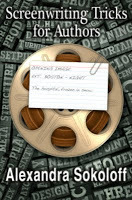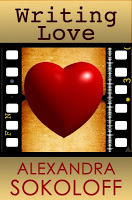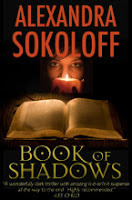Nanowrimo Prep: Story Elements Checklist
As any of you who are brainstorming Index Cards
right now have found, this is not an orderly process. You will be
coming up with scenes in no order whatsoever, all over the structure
grid. Some that you will have no idea where to put. And so while this week I
will be working ahead through story structure in a relative order, I
want to re-post the whole general Story Elements Checklist, so you have a
whole overview of scenes and story elements you will be needing beyond
whatever act we happen to be talking about at the time.
When
you start out brainstorming index cards, you can make cards for all of
the elements below, even if you have no idea what those scenes might
look like, because with only one or two exceptions (which I've noted
below), these are scenes and elements that are going to appear in your
story no matter what genre you're writing in.
Even
better - they're almost certainly going to appear in the Act in which
I've listed them below. There are exceptions, of course, but those are
rare. When you start looking at
stories for where these elements turn up, and noticing how prevalent
the patterns are, it will make plotting out any story so much easier you
won't even believe it. And I'm a big believer that just asking the
question will get your subconscious working on the perfect answer.
Write out the card in the most general sense today, and you may well
wake up with the perfect scene tomorrow morning.
STORY ELEMENTS CHECKLIST FOR GENERATING INDEX CARDS
ACT ONE
* Opening image
* Meet the hero or heroine in the ordinary world
* Hero/ine’s inner and outer desire.
* Hero/ine's ghost or wound
* Hero/ine’s arc -
* Inciting Incident/Call to Adventure
*
Meet the antagonist (and/or introduce a mystery, which is what you do
when you’re going to keep your antagonist hidden to reveal at the end)
* State the theme/what’s the story about?
* Allies
* Mentor (possibly. You may not have one or s/he may be revealed later in the story).
* Love interest (probably)
* Plant/Reveal (or: Set ups and Payoffs)
* Hope/Fear (and Stakes)
* Time Clock (possibly. May not have one or may be revealed later in the story)
* Sequence One climax
* Plan, Central Question, Central Story Action
* Act One climax
---------------------------------------------------------------------------------------
ACT TWO, PART ONE
* Crossing the Threshold/ Into the Special World (may occur in Act One)
* Threshold Guardian/Guardian at the Gate (possibly)
* Hero/ine’s Plan
* Antagonist’s Plan
* Training Sequence (possibly)
* Series of Tests
-
* Picking up new Allies
* Assembling the Team (possibly)
* Attacks by the Antagonist (whether or not the Hero/ine recognizes these as coming from the antagonist)
* In a detective story, Questioning Witnesses, Lining Up and Eliminating Suspects, Following Clues.
*Bonding with Allies
THE MIDPOINT
* Completely changes the game
* Locks the hero/ine into a situation or action
* Can be a huge revelation
* Can be a huge defeat
* Can be a “now it’s personal” loss
* Can be sex at 60 – the lovers finally get together, only to open up a whole new world of problems
----------------------------------------------------------------------------------
ACT TWO, PART TWO
*
Recalibrating – after the shock or defeat of the game-changer in the
midpoint, the hero/ine must Revamp The Plan and try a New Mode of
Attack.
* Escalating Actions/ Obsessive Drive
* Hard Choices and Crossing The Line (immoral actions by the main character to get what s/he wants)
* Loss of Key Allies (possibly because of the hero/ine’s obsessive actions, possibly through death or injury by the antagonist).
* A Ticking Clock (can happen anywhere in the story)
* Reversals and Revelations/Twists.
* The Long Dark Night of the Soul and/or Visit to Death (also known as: All Is Lost)
* In a romance or romantic comedy, the All Is Lost moment is often a The Lover Makes A Stand scene
THE SECOND ACT CLIMAX
* Often can be a final revelation before the end game: the knowledge of who the opponent really is
* Answers the Central Question
------------------------------------------------------------------------
ACT THREE
The
third act is basically the Final Battle and Resolution. It can often
be one continuous sequence – the chase and confrontation, or
confrontation and chase. There may be a final preparation for battle,
or it might be done on the fly. Either here or in the last part of
the second act the hero will make a new, FINAL PLAN, based on the new
information and revelations of the second act.
The essence of a third act is the final showdown between protagonist and antagonist. It is often divided into two sequences:
1. Getting there (Storming the Castle)
2. The final battle itself
* Thematic Location - often a visual and literal representation of the Hero/ine’s Greatest Nightmare
* The protagonist’s character change
* The antagonist’s character change (if any)
* Possibly ally/allies’ character changes and/or gaining of desire
*
Possibly a huge final reversal or reveal (twist), or even a whole
series of payoffs that you’ve been saving (as in Back to the Future and
It’s A Wonderful Life)
* RESOLUTION: A glimpse into
the New Way of Life that the hero/ine will be living after this whole
ordeal and all s/he’s learned from it.
* Closing Image
Now,
I'd also like to remind everyone that this is a basic, GENERAL list.
There are story elements specific to whatever kind of story you're
writing, and the best way to get familiar with what those are is to do
the story breakdowns on three (at least) movies or books that are
similar to the KIND of story you're writing.
I
strongly recommend that you watch at least one, or much better, three of
the films I break down in the workbooks, following along with my notes.
I do full breakdowns of Chinatown, Harry Potter and the Sorcerer's Stone, Romancing the Stone, and The Mist, and act breakdowns of You've Got Mail, Jaws, Silence of the Lambs, Raiders of the Lost Ark in Screenwriting Tricks For Authors.
I do full breakdowns of The
Proposal, Groundhog Day, Sense and Sensibility, Romancing the Stone,
Leap Year, Notting Hill, Four Weddings and a Funeral, Sea of Love, While
You Were Sleeping and New in Town in Writing Love.
Screenwriting Tricks for Authors and Writing Love, Screenwriting Tricks for Authors, II, are now available in all e formats and as pdf files. Either book, any format, just $2.99.
- Alex

- Kindle
- Amazon UK
- Amaxon DE (Eur. 2.40)
 - Smashwords (includes online viewing and pdf file)
- Smashwords (includes online viewing and pdf file)
- Amazon/Kindle
- Barnes & Noble/Nook
- Amazon UK
- Amazon DE
=====================================================
HALLOWEEN GIVEAWAY
It's
October, my favorite month, and you-know-what is coming, so I'm giving
away 15 signed hardcover copies of my spooky thriller Book of Shadows . To enter, just sign up for my mailing list at http://alexandrasokoloff.com (the box on the left of the screen.)

Book of Shadows .
An
ambitious Boston homicide detective must join forces with a beautiful,
mysterious witch from Salem in a race to solve a series of satanic
killings.
Amazon Bestseller in Horror and Police Procedurals
"A wonderfully dark thriller with amazing 'Is-it-isn't-it?' suspense all the way to the end. Highly recommended."
- Lee Child
right now have found, this is not an orderly process. You will be
coming up with scenes in no order whatsoever, all over the structure
grid. Some that you will have no idea where to put. And so while this week I
will be working ahead through story structure in a relative order, I
want to re-post the whole general Story Elements Checklist, so you have a
whole overview of scenes and story elements you will be needing beyond
whatever act we happen to be talking about at the time.
When
you start out brainstorming index cards, you can make cards for all of
the elements below, even if you have no idea what those scenes might
look like, because with only one or two exceptions (which I've noted
below), these are scenes and elements that are going to appear in your
story no matter what genre you're writing in.
Even
better - they're almost certainly going to appear in the Act in which
I've listed them below. There are exceptions, of course, but those are
rare. When you start looking at
stories for where these elements turn up, and noticing how prevalent
the patterns are, it will make plotting out any story so much easier you
won't even believe it. And I'm a big believer that just asking the
question will get your subconscious working on the perfect answer.
Write out the card in the most general sense today, and you may well
wake up with the perfect scene tomorrow morning.
STORY ELEMENTS CHECKLIST FOR GENERATING INDEX CARDS
ACT ONE
* Opening image
* Meet the hero or heroine in the ordinary world
* Hero/ine’s inner and outer desire.
* Hero/ine's ghost or wound
* Hero/ine’s arc -
* Inciting Incident/Call to Adventure
*
Meet the antagonist (and/or introduce a mystery, which is what you do
when you’re going to keep your antagonist hidden to reveal at the end)
* State the theme/what’s the story about?
* Allies
* Mentor (possibly. You may not have one or s/he may be revealed later in the story).
* Love interest (probably)
* Plant/Reveal (or: Set ups and Payoffs)
* Hope/Fear (and Stakes)
* Time Clock (possibly. May not have one or may be revealed later in the story)
* Sequence One climax
* Plan, Central Question, Central Story Action
* Act One climax
---------------------------------------------------------------------------------------
ACT TWO, PART ONE
* Crossing the Threshold/ Into the Special World (may occur in Act One)
* Threshold Guardian/Guardian at the Gate (possibly)
* Hero/ine’s Plan
* Antagonist’s Plan
* Training Sequence (possibly)
* Series of Tests
-
* Picking up new Allies
* Assembling the Team (possibly)
* Attacks by the Antagonist (whether or not the Hero/ine recognizes these as coming from the antagonist)
* In a detective story, Questioning Witnesses, Lining Up and Eliminating Suspects, Following Clues.
*Bonding with Allies
THE MIDPOINT
* Completely changes the game
* Locks the hero/ine into a situation or action
* Can be a huge revelation
* Can be a huge defeat
* Can be a “now it’s personal” loss
* Can be sex at 60 – the lovers finally get together, only to open up a whole new world of problems
----------------------------------------------------------------------------------
ACT TWO, PART TWO
*
Recalibrating – after the shock or defeat of the game-changer in the
midpoint, the hero/ine must Revamp The Plan and try a New Mode of
Attack.
* Escalating Actions/ Obsessive Drive
* Hard Choices and Crossing The Line (immoral actions by the main character to get what s/he wants)
* Loss of Key Allies (possibly because of the hero/ine’s obsessive actions, possibly through death or injury by the antagonist).
* A Ticking Clock (can happen anywhere in the story)
* Reversals and Revelations/Twists.
* The Long Dark Night of the Soul and/or Visit to Death (also known as: All Is Lost)
* In a romance or romantic comedy, the All Is Lost moment is often a The Lover Makes A Stand scene
THE SECOND ACT CLIMAX
* Often can be a final revelation before the end game: the knowledge of who the opponent really is
* Answers the Central Question
------------------------------------------------------------------------
ACT THREE
The
third act is basically the Final Battle and Resolution. It can often
be one continuous sequence – the chase and confrontation, or
confrontation and chase. There may be a final preparation for battle,
or it might be done on the fly. Either here or in the last part of
the second act the hero will make a new, FINAL PLAN, based on the new
information and revelations of the second act.
The essence of a third act is the final showdown between protagonist and antagonist. It is often divided into two sequences:
1. Getting there (Storming the Castle)
2. The final battle itself
* Thematic Location - often a visual and literal representation of the Hero/ine’s Greatest Nightmare
* The protagonist’s character change
* The antagonist’s character change (if any)
* Possibly ally/allies’ character changes and/or gaining of desire
*
Possibly a huge final reversal or reveal (twist), or even a whole
series of payoffs that you’ve been saving (as in Back to the Future and
It’s A Wonderful Life)
* RESOLUTION: A glimpse into
the New Way of Life that the hero/ine will be living after this whole
ordeal and all s/he’s learned from it.
* Closing Image
Now,
I'd also like to remind everyone that this is a basic, GENERAL list.
There are story elements specific to whatever kind of story you're
writing, and the best way to get familiar with what those are is to do
the story breakdowns on three (at least) movies or books that are
similar to the KIND of story you're writing.
I
strongly recommend that you watch at least one, or much better, three of
the films I break down in the workbooks, following along with my notes.
I do full breakdowns of Chinatown, Harry Potter and the Sorcerer's Stone, Romancing the Stone, and The Mist, and act breakdowns of You've Got Mail, Jaws, Silence of the Lambs, Raiders of the Lost Ark in Screenwriting Tricks For Authors.
I do full breakdowns of The
Proposal, Groundhog Day, Sense and Sensibility, Romancing the Stone,
Leap Year, Notting Hill, Four Weddings and a Funeral, Sea of Love, While
You Were Sleeping and New in Town in Writing Love.
Screenwriting Tricks for Authors and Writing Love, Screenwriting Tricks for Authors, II, are now available in all e formats and as pdf files. Either book, any format, just $2.99.
- Alex

- Kindle
- Amazon UK
- Amaxon DE (Eur. 2.40)
 - Smashwords (includes online viewing and pdf file)
- Smashwords (includes online viewing and pdf file)- Amazon/Kindle
- Barnes & Noble/Nook
- Amazon UK
- Amazon DE
=====================================================
HALLOWEEN GIVEAWAY
It's
October, my favorite month, and you-know-what is coming, so I'm giving
away 15 signed hardcover copies of my spooky thriller Book of Shadows . To enter, just sign up for my mailing list at http://alexandrasokoloff.com (the box on the left of the screen.)

Book of Shadows .
An
ambitious Boston homicide detective must join forces with a beautiful,
mysterious witch from Salem in a race to solve a series of satanic
killings.
Amazon Bestseller in Horror and Police Procedurals
"A wonderfully dark thriller with amazing 'Is-it-isn't-it?' suspense all the way to the end. Highly recommended."
- Lee Child
Published on October 16, 2013 09:29
No comments have been added yet.



